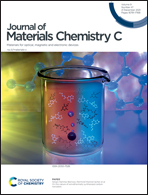Capturing excitonic and polaronic effects in lead iodide perovskites using many-body perturbation theory†
Abstract
Lead iodide perovskites have attracted considerable attention as promising energy-materials. However, to date, several key electronic properties such as optical properties, effective mass, exciton binding energy and radiative exciton lifetime are largely unknown. Here, we employ an integrated approach with several state-of-the-art first-principles based methodologies viz. hybrid density functional theory combined with spin–orbit coupling, many-body perturbation theory, model-BSE (mBSE), Wannier–Mott and density functional perturbation theory to address these properties by taking a prototypical model system viz. APbI3 (A = Formamidinium (FA), methylammonium (MA), and Cs). We demonstrate that while the mBSE approach improves the excitonic features in the optical spectra, the Wannier–Mott approach and ionic contribution to dielectric screening ameliorate the exciton binding energy. Moreover, the direct–indirect bandgap transition (Rashba–Dresselhaus splitting) may be responsible for the reduced charge carrier recombination rate in MAPbI3 and FAPbI3. In addition, we examine the electron–phonon coupling constants and polaron parameters that may provide valuable insights into charge-carrier generation and transport. Furthermore, the role of cation “A” in procuring the long-lived exciton lifetime is well understood.



 Please wait while we load your content...
Please wait while we load your content...